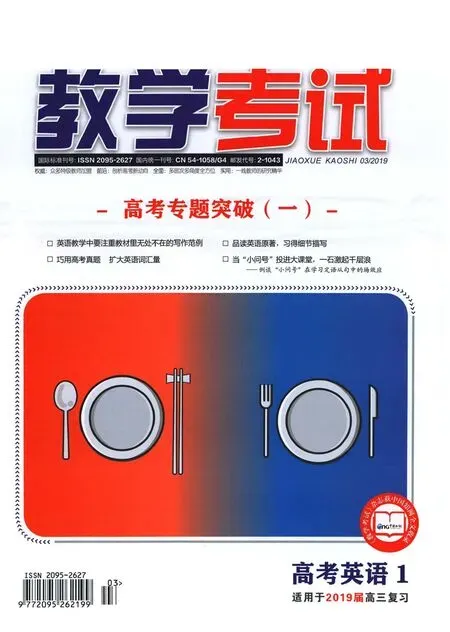不拘一格出试题
——听力试题原创漫谈
宁夏
问:魏老师,您好,作为教学考试杂志社“优师计划研发方向五——二轮知识体系巩固与测评的研究与实践项目”第三阶段T3小组的命题老师,在这次原创命题过程中,您的感受是什么呢?
答:诚惶诚恐,但是又心怀感恩。自己也是参与过多次命题工作的“老江湖”了,可心里还是忐忑不安。
问:在这次命题工作中,您具体负责的是哪部分试题呢?
答:我负责命制从听力到七选五的原创试题。
问:在您负责命制的题型中,您觉得哪种题型最难命制呢?
答:当然是听力试题了,这个是最让人纠结的。从网络教研以及审题老师的反馈中可以发现,改动最大的部分就是听力试题。
问:您能介绍一下您命制听力试题的思路和过程吗?
答:当然可以。只是我说的这些都是我个人的看法,不一定对啊。
问:没有关系的。
答:在命制听力试题时,首先得有理论依据,不能自己凭空臆断。所以我要了解考试说明对高考听力的要求,做到心中有数。
问:那这些要求是什么呢?
答:要求考生听懂熟悉的有关日常生活话题的简短独白和对话。考生应能:(1)理解主旨要义;(2)获取事实性的具体信息;(3)对所听内容作出简单推断;(4)理解说话者的意图、观点和态度。
问:好像明白了些,可是这些都是对题干的要求,对于具体的内容,好像没有具体的说明?
答:是的,当我对高考听力的要求有所了解后,就要对试题内容进行选择了。这就需要我研读最新的课程标准,知道高考考查的内容是什么。比如,高考要从人与自我、人与社会和人与自然三个方面对考生进行学科核心素养的渗透。
问:人与自我涉及哪些方面呢?
答:1.个人、家庭、社区及学校生活;2.健康的生活方式、积极的生活态度;3.认识自我,丰富自我,完善自我;4.乐于学习,善于学习,终身学习;5.语言学习的规律、方法等;6.优秀品行,正确的人生态度,公民义务与社会责任;7.生命的意义与价值;8.未来职业发展趋势,个人职业倾向、未来规划等;9.创新与创业意识。
问:人与社会涉及哪些方面呢?
答:1.良好的人际关系与社会交往;2.公益事业与志愿服务;3.跨文化沟通、包容与合作;4.小说、戏剧、诗歌、传记、文学简史、经典演讲、文学名著等;5.绘画、建筑等领域的代表性作品和人物; 6.影视、音乐等领域的概况及其发展;7.体育活动、大型体育赛事、体育与健康、体育精神;8.不同民族文化习俗与传统节日;9.对社会有突出贡献的人物;10.重要国际组织与社会公益机构;11.法律常识与法治意识等;12.物质与非物质文化遗产;13.社会热点问题;14.重大政治、历史事件,文化渊源;15.社会进步与人类文明;16.科技发展与信息技术创新,科学精神,信息安全。
问:人与自然方面呢?
答:1.主要国家地理概况;2.自然环境、自然遗产保护;3.人与环境、人与动植物;4.自然灾害与防范,安全常识与自我保护;5.人类生存、社会发展与环境的关系;6.自然科学研究成果;7.地球与宇宙奥秘探索。
问:这些任务都完成了,就可以开始命题了吗?
答:可以了。同时我还要分析一下2018年全国卷Ⅱ听力试题的构成、分配、词数和话题等方面,尽力做到向高考真题靠近。
问:那您的分析结果是怎样的呢?
答:10个语篇,20道题。题量分布是5,2,2,3,4,4。总词数为812。事实细节题11道,推理判断题5道,主旨大意题1道,观点态度题3道。各个题的内容和词数分别是Text 1德语学习情况,42词;Text 2邀请参加派对,28词;Text 3买火车票,28词;Text 4谈论一个餐馆,32词;Text 5面试是否顺利,34词;Text 6写完作业后去放风筝,84词;Text 7商量周日下午做什么,92词;Text 8节目中谈论猫的习性,153词;Text 9谈论孩子在幼儿园的表现,158词;Text 10谈自己学习跳舞到最后放弃的经历,161词。
问:哇,这么细致啊,现在可以命题了吗?
答:可以了。完成了以上的工作,总算是可以正式命题了。
问:听力原文都是您自己编写的吗?
答:不可能啊,我是中国人,我的思路都是中国人的思路。命制的是英语试题,当然要依据外国人的思路。
问:那您是怎样克服思路上的困难的呢?
答:主要是通过浏览外文网站以及阅读其他听力试题,来选择合适的方向和文本。具体来说,我的命题方向可以总结为“四个一”。即改一改、编一编、加一加和减一减。
问:什么是改一改呢?
答:举例来说,改一改就是在原有听力内容的基础上,进行一些改动,比如2018年全国卷Ⅱ听力试题的第1题原文:
W: So how is your German class going, John?
M: Well, not bad.The pronunciation is fine with me.And its vocabulary is similar to English, but I’m finding the grammar awful.
W: Well, it takes a while to get it right.
对话是两位学生讨论德语学习情况。对此我可以换个场景,如两个学生讨论体育课、数学课或物理课等。改编后的内容可以是这个样子的:
W: The chemistry class is so hard.Don’t you think so,John?
M: Well, I like it.You know science is always my favorite.I like the feeling to deal with the puzzle step by step.But sometimes, it also makes me upset, for I often mess up the experiment.
问:我明白了,就是根据原有的文本,进行场景的替换,话题的内容随之发生变化,对吗?
答:是这样的。
问:什么是编一编呢?
答:编一编,就是选择已经命制好的试题,根据试题的设问,自己创设场景,进行人物对话,比如2018年全国卷Ⅱ听力试题的第2题:
What is the probable relationship between the speakers?
A.Colleagues.
B.Brother and sister.
C.Teacher and student.
这是一道推理判断题,判断两位说话者之间的关系,他们之间可能是同事关系,也可能是兄妹关系,还可能是师生关系。我在命题的时候,保持设问不变,将两者之间的对话内容设成这样:
W: John, have you asked for a leave to your boss?
M: Of course.I also told Mr.Lee that I can’t take my son Tom to have lessons tomorrow.Don’t worry.I won’t miss our mother’s birthday party.
这样,考查的虽然还是推断人物关系,但已经不是原来的内容了。
问:我明白了,也就是说,您可以通过设问来反推听力的内容,对吗?
答:对,没错。
问:那什么又是加一加呢?
答:加一加就是在原有的听力文本内容中添加其他话题,使得话题更加完整。比如2018年全国卷Ⅱ听力试题的第3题原文:
W: May I help you?
M: Yes.When is the next train to London?
W: Oh, let me check.It leaves in twenty minutes.
M: One ticket, please.
这是一段有关购买火车票的对话,我可以再添加一些内容,使得对话更加完整,在设置问题的时候,也可以有更多的选择空间,如:
W: May I help you?
M: Yes.When is the next train to London?
W: Oh, let me check.Oh, the next train to London will leave tomorrow.And the first one is at 7:00 am.
M: Well, that’s too early.I usually get up at 7:30 am.Is there a train between 9:00 and 10:00 in the morning.
W: Yes, there is one at 9:45 am.
M: That’s fine with me.How much is the ticket?
W: 45 pounds for an adult and 30 pounds for a kid under 12.
M: I want two tickets for adults and one for a kid.
问:减一减就是把长文本变短吗?
答:没错,网络上的很多文本非常长,比如BBC的6 Minute English节目,一篇文本几乎上千词,肯定不适合作为听力材料,这就要求我们根据需要,从长文本中选取一段进行编写。
问:根据您的叙述,好像听力试题并不难命制,只要清楚这四点就可以了。
答:那您试试把这篇320词的新闻改编成200词以内的短文并设置4个问题,不准出现超纲的词汇。
Accidents will happen.Mistakes will be made.It’s an unavoidable part of life.But what’s important is how we reflect on those mistakes and learn from them.Japan’s train industry, responsible for transporting millions of people each day, understandably takes safety very seriously.And their introspection and dedication to not repeating the past was on full display recently when JR East, one of the country’s major passenger railway companies, unveiled the new expansion to their“Exhibition Hall of Historical Accidents”.
The Exhibition Hall, which originally opened in 2002, is a fascinating glimpse into the Japanese psyche of introspection.If you’ve ever worked in a Japanese company, you’re probably familiar with the term hanseikai (反省会), which loosely translates as“introspection meeting.”During the meeting,those involved in an event will discuss what went wrong, and how it can be improved upon.In reality it’s perhaps the boss yelling at his or her subordinates, pointing out their mistakes.But in theory, the idea is to expose errors, rather than hide them,as a means of reflection and learning.Failure is more likely to trigger reflection than success.And reflection, not experience,is the key to learning.The Exhibition Hall of Historical Accidents is, in essence, a permanent large-scale hanseikai.
JR East recently completed an expansion of their exhibition hall.“We want our employees to never forget the accidents of the past so that we can reflect on the incidents and learn from them”said the company (PDF), reasserting the importance of this initiative.The new exhibition hall consist of video footage,slides, panels and digital signage, combined with newspaper clippings, reports and other documentations from accidents.In the newly added reference hall are real-scale replicas of trains that have been in accidents.
The new exhibition hall was unveiled to the press on October 9, 2018.Unfortunately, it is only open to employees of the company and is not for the public.
问:呃,这个确实有些难度,那您是怎么做的呢?
答:做到以下方面:选材语境明确;内容完整,信息量充足,不含超纲词汇,人名、地名可以出现;不选择别人出过的题;内容真实;长短适宜;首句不设题;考点分布均匀;题干和选项简明扼要;不出现不听就能选对的答案;答案唯一;选项平行,不出现包容的关系,干扰项有效;选项分布均衡,考查点不重合。
问:天哪,这么复杂啊!
答:是啊,你不知道,在找资料的时候,多么揪心啊,找一个,有人用过了,再找一个,又有人用过了,哭死的心都有啊。
问:对了,那您刚刚说的那个短文最后是怎样设题的呢?
答:Accidents will happen.Mistakes will be made.It’s an unavoidable part of life.But what’s important is how we reflect on those mistakes and learn from them.Japan’s train industry, responsible for transporting millions of people each day, takes safety very seriously.(17)JR East, one of the country’s major passenger railway companies, organized the new “Exhibition Hall of Historical Accidents”.
The Exhibition Hall, (18)which originally opened in 2002, is fascinating.The Exhibition Hall of Historical Accidents is, in essence, a permanent large-scale learning place.
JR East recently completed an expansion of their exhibition hall.“We want our employees to never forget the accidents of the past so that we can reflect on the incidents and learn from them” said the company.
The new exhibition hall consists of video footage, slides,combined with newspaper, reports and other documents from accidents.(19)In the newly added reference hall are realscale parts of trains that have been in accidents.
The new exhibition hall was reopened to the press on October 9, 2018.Unfortunately, (20)it is only open to employees of the company and is not for the public.
听第10段材料,回答第17至20题。
17.Who organized the Historical Accidents Hall?
A.JR East.
B.Japan Train Industry parts.
C.The passager railway companies.
18.How long does the Hall exist?
A.Only 15 years.
B.More than 15 years.
C.Less than 15 years.
19.What can you see in the Hall?
A.Video games.
B.Fashion newspaper.
C.Damaged trains.
20.What can we know about the new exhibition hall?
A.It will open in 2018.
B.It is only for the employees.
C.It attracts the huge public.
问:谢谢您,听了您的讲解我对听力原创试题的命制已有所了解,受益匪浅,以后有这样的机会我也要参加原创试题命制。
答:我也要谢谢我们团队的各位老师,我们在一起教研收获很多,共同进步。

